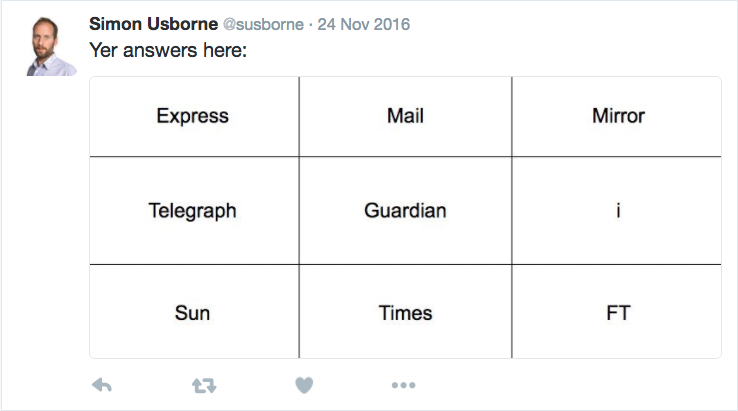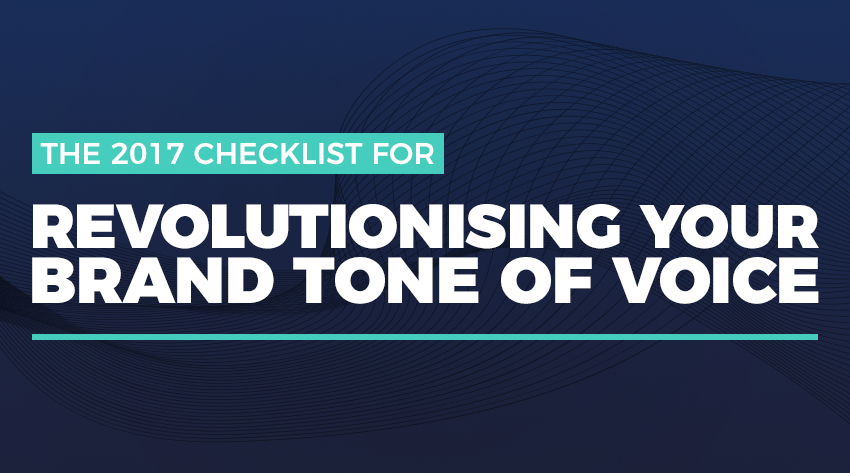The things we say are important. But so too is the way we say them.
When we speak, we’re able to establish our tone by varying our volume, intonation and body language – factors which are every bit as important as the words we choose.
Defining tone of voice is just as important when it comes to the written word, but it’s much harder to get across... Not having the benefit of volume, intonation or body language can make it difficult to convey the tone of the words we choose when they rest on a page, and it’s harder still to communicate it to people writing on your behalf.
Yet, establishing your tone of voice for your brand’s written words is worth doing. After all, get it right and you’ll be talking to your customers in a way that ‘connects’ with them. Even on a subconscious level, customers will appreciate the rapport you’re building, you’ll win their trust, and you’ll been seen as a someone worth doing business with.
So, why not make defining your tone of voice your number one new years’ resolution for 2017? You’ll find that your content gets an awful lot better and that will, in turn, give a boost to your overall marketing efforts.
But, before we dive into looking at how to define your tone of voice, let’s take a step back.
Right from the start it’s important to think about what a tone of voice is, and just as importantly, what it isn’t.
Defining your tone of voice is not an exercise in deciding what your content should be or what types of content you should generate. It’s not about the platforms you publish content on. It’s not about outlining your style guide. And, it’s not about identifying a series of personas to represent your target customer. Those are all separate – and important – exercises. In short, it’s not your message. Instead, it’s how you convey your message through words.
Here’s where to start when defining your tone of voice
A good place to begin is by looking back at the corporate values you’ve already established. This will enable you to check you’ve a good grasp of what your business is, focusing on the two or three sentences that sum up what you offer, what separates you from your competitors, and what you’re aiming to achieve.
If you don’t have this sort of thing to hand, or the material you have has dated, now is the right time to get it sorted: see if you can sum up what your business stands for in around 140 characters (the length of a tweet).
Then, once you’re clear about your business’s identity, it’s time to think about how you’re going to talk to your customers through your content.
As we’ve already established, defining and communicating your tone of voice isn’t always easy. However, we’ve come up with six questions that you can ask yourself. The answers to these could well deliver a shorthand way of summing up your tone of voice, and we find that they make for a particularly effective way of conveying what your tone of voice is to anyone else who needs to know it, such as agencies writing on your behalf.
6 key questions to ask yourself when defining your tone of voice
- If your brand were a radio station, which one would you be?
This might sound odd but bear with us. Pointing to a ‘real world’ example like this will help to contextualise your tone of voice, as whoever is writing on your behalf (if you’re not doing the writing yourself) will have a better understanding of how you want to sound.
For instance, if you say “we’re more Radio 4 than Radio 1”, you can begin to place your tone of voice on a sliding scale. Radio 1 is generally regarded as being a station that serves a younger audience with its energy, informality and fast-pace, whereas Radio 4 is typically associated with a more mature audience, with more formality and structure.
However, if you’re struggling to align yourself with feel of an entire station, can you point to a particular scheduling window or even programme instead? For instance, Radio 4’s The World at One conveys a slightly different tone to Radio 4’s Woman’s Hour, as does Radio 1’s Newsbeat and Radio 1’s Breakfast Show.
- If your brand were a TV station, which one would you be?
Is your brand ITV on a Saturday night, or are you BBC Four in the middle of the week? We’ve pointed to specific scheduling times due to the fact that television stations filled with so many tones of voice that it can be tough to identify just one that represents the entire station.
However, spend enough time watching Channel 4 and you’ll quickly see that it’s a channel that’s alternative, bold and experimental. ITV, on the other hand, is almost synonymous with popular culture in the UK, and BBC Four has an entirely different air about it, with a tone that conveys intellect, culture, authority and expertise.
Again, you needn’t point to a specific channel if you find it easier to point to a specific programme within it, or a scheduling slot. Just see if you identify with one channel more strongly than another.
- If your brand were television programme, which one would you be?
By now you’ll know the format and see where we’re going with this. But, just take a step back to really pick this one apart: MasterChef and The Great British Bake Off are, in many ways, the same programme. Passionate contestants compete to be the best in their field, serving great food and being judged by professionals. What differentiates the programmes so much (aside from the content itself) is the tone of voice that’s used.
Think about the tone of voice each programme utilises. One programme is competitive, fast-paced and ‘professional’ – the other reflects comradery, nostalgia and amateurs giving it their best. The tone of voice used by the presenters and audio narrators is deliberately aligned with this. So, is your brand more GBBO or MasterChef? Million Pound Drop or Mastermind? Again, see if you can position yourself towards one programme, but just be careful not to dwell too much on the content of each programme – that’s not the point of this exercise. Focus instead on how they’re making you feel about the content while you’re watching.
- A magazine or newspaper
Newspapers and magazines need to find their own tone of voice to speak to their readers. If you point to one that fits your business, it can be a really useful way of choosing the wording that speaks to your customers, as well as helping your writers to establish a cohesive tone.
Think about what your customers like to read (something that will become apparent during your persona work) and see if there are any publications you can use as a guide.
When it comes to newspapers, you’ll notice that tone underpins a political message. Take a look at this example where journalist Simon Usborne picks out the intros of each paper’s story about the Autumn Statement:

Aside from the political slant, you should notice the way in which language is used to deliver the same information in a different tone.*
But, just as a friendly reminder - don’t get too bogged down with a newspaper’s political leanings. Ask yourself if you are more like the i (a short, to-the-point digest), or a traditional ‘broadsheet’ like The Telegraph (long-form, serious, formal) – you don’t have to agree with the message itself.
- If your brand were a famous person, who would you be?
This is perhaps the hardest question of all to answer, as it’s very unlikely you’ll be able to point to a single person that embodies everything about your brand. But, try this exercise anyway: being able to say you’re “more this person than that person” is still very useful.
For instance, if your brand were a quiz show host, would you be John Humphrys or Davina McCall? Do you want readers to feel that your copy is forthright and cutting, or quirky and informal? You may prefer to align yourself somewhere on a spectrum between the two, but being able to say your tone of voice is more similar to Humphrys’ than McCall’s will help you to establish what you don’t want to be, as much as what you do want to be.
- A meeting place
You might find that your voice is best summed up by a location and the sort of tone that is most commonly associated with it. So, if your business were a person, where would you meet us? Would you grab a stool in a Starbucks, book us in for a black-tie dinner or invite us for a pint in your local?
The way you would speak to people in all of these locations is different - even if you took the same person to each place! So, if you’ve ever instructed someone to ‘write as if you were talking to a friend’, make sure you qualify it with ‘in the pub, in a café’ or wherever else. Essentially, try to be specific: which friend? And where are you meeting?
A few things to bear in mind…
Don’t overcomplicate the matter:
Rest assured, it’s not necessary to identify your brand’s tone of voice using all six of these question points. It’s unlikely you’ll be able to answer every single one with confidence, and in fact, trying to do so could quickly see you becoming frustrated!
Therefore, don’t place equal weight to the answers from every one of these questions – you’ll inevitably find that some results conflict and contradict one another. Instead, what’s important is that you just find a couple of answers that resonate with you. Act on the ones that you can answer most naturally, or the answers that you can feel you can best justify to other people. Don’t get too attached to the rest.
Look for themes:
If you’ve managed to find two or three answers that resonate with you, look at how they fit together. Do they make sense if you pull them out and examine the results as a whole? Or do they contradict one another? If they don’t fit well, re-evaluate your answers, or consider disregarding the question that’s posing as the outlier.
Dig out your company’s core values:
Before you start trying to define your tone of voice, make sure you have those core values to hand. Once you feel you have got a stronger handle on what your tone of voice is, refer back to your core values and mission statement (or anything else that identifies what your business is and what you stand for), checking your tone of voice is well-aligned.
Beware listing endless adjectives:
You’ll have noticed that at no point in this exercise have we suggested that you simply offer up a list of words to describe your tone of voice. Adjectives such as ‘friendly’, ‘personal’, ‘professional’ (or our pet peeve, ‘human’), are subjective and, in some respects, should go without saying. Who, for example, wants a tone of voice that is ‘unfriendly’, ‘unprofessional’ and ‘robotic’? You’ll find that you start using adjectives when you’re explaining why you’ve hit upon the answers you’ve reached, and that’s absolutely fine – but don’t offer them without the kind of context these kinds of questions illicit.
Don’t overlook the power of formatting and punctuation when you’re thinking about tone of voice:
Without allowing yourself to veer into the territory of ‘house style’, bear in mind that italicising, bolding, underlining and using punctuation are all effective and necessary replacements for the communication factors we lack in written words. Intonation, body language and volume can be substituted with astute formatting. Perhaps you didn’t notice, but we’ve actually used formatting all the way throughout this post to help you read it in the tone we intended. Scroll through again and see if you can spot it.
Have you identified your tone of voice now?
Now that you’re equipped with these questions and top tips, hopefully you’ll find it easier to define your tone of voice this year. It’s really important that you give some time to nailing it down as it will ensure that your copy is achieving maximum impact in all of the formats in which your brand has a voice – from social media to white papers, right the way through to product packaging and monthly newsletters.
Of course, feel free to have a go at defining your tone of voice in other ways – our suggestions aren’t exhaustive! For instance, can you point to a brand you think has a particularly strong tone of voice you’d like to take inspiration from? Virgin and British Airways both sell the same ‘thing’ (to an extent), and operate in the same market, yet their tones of voice are distinct and entirely different. If you like what one of them is doing regarding their tone of voice, be sure to communicate that to the people writing for your business: particularly your agency.
You could also run an analysis of the language your customers are using. This doesn’t mean that you need to use the same words, phrases, sentence lengths or contractions that your customers are using, but it will give some useful clues regarding the way to ‘speak to them’.
Finally, bear in mind that defining your tone of voice is only going to be as useful as the depth of understanding your colleagues and agency has of it. You’ll need to do some more work around deploying it successfully… which is a post for another day!
*Here’s the answers to the above ‘newspaper intro’ quiz in case you were wondering:

Sign up for our monthly newsletter and follow us on social media for the latest news.





 Proudly part of IPG Mediabrands
Proudly part of IPG Mediabrands